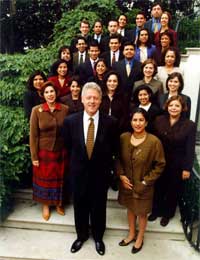Hispanic, as used in the United States, is one of several terms used to categorize persons whose ancestry hails either from Spain, the Spanish-speaking countries of Latin America, or the original settlers of the traditionally Spanish-held Southwestern United States. The term is used as a broad form of classification in the U.S. census, local and federal employment, and numerous business market researches.
 In the U.S. some people consider "Hispanic" to be too general as a label, while others consider it offensive, often preferring to use the term "Latino", which is viewed as a self-chosen label. The preference of "Latino" over "Hispanic" is partly because it more clearly indicates that those it is referring to are the people from Latin America, and not Spain. Different labels prevail in different regions, as well. In places like Arizona and California, the Chicanos are proud of their personal association and their participation in the agricultural movement of the 1960s with César Chávez, that brought attention to the needs of the farm workers. Usually younger Hispanics will not refer to themselves as such, however. In the U.S. some people consider "Hispanic" to be too general as a label, while others consider it offensive, often preferring to use the term "Latino", which is viewed as a self-chosen label. The preference of "Latino" over "Hispanic" is partly because it more clearly indicates that those it is referring to are the people from Latin America, and not Spain. Different labels prevail in different regions, as well. In places like Arizona and California, the Chicanos are proud of their personal association and their participation in the agricultural movement of the 1960s with César Chávez, that brought attention to the needs of the farm workers. Usually younger Hispanics will not refer to themselves as such, however.

 Roughly one in seven Americans is Hispanic. Hispanics constitute the largest minority group in the United States. As of July 1, 2004, Hispanics accounted for 14.1 percent of the population, around 41.3 million people. Hispanic growth rate over the July 1, 2003 to July 1, 2004 period was of 3.6 percent - higher than any other ethnic group in the United States, and in fact more than three times the rate of the nation's total population (at 1.0 percent). The projected Hispanic population of the United States for July 1, 2050, is of 102.6 million people. According to this projection, Hispanics will constitute 24% of the nation’s total population on that date. Roughly one in seven Americans is Hispanic. Hispanics constitute the largest minority group in the United States. As of July 1, 2004, Hispanics accounted for 14.1 percent of the population, around 41.3 million people. Hispanic growth rate over the July 1, 2003 to July 1, 2004 period was of 3.6 percent - higher than any other ethnic group in the United States, and in fact more than three times the rate of the nation's total population (at 1.0 percent). The projected Hispanic population of the United States for July 1, 2050, is of 102.6 million people. According to this projection, Hispanics will constitute 24% of the nation’s total population on that date.
Of the nations total Hispanic population, 49% lives in California or Texas. New Mexico is the state with the highest proportion of Hispanics, with 43% being of Hispanic-origin, followed by California and Texas, at 35 percent each. The Hispanic population of Los Angeles County, California - numbering over 4.6 million - is the largest of any county in the nation.
Sixty-four percent of the nation's Hispanic population are of Mexican background. Another approximately 10 percent are of Puerto Rican background, with about 3 percent each of Cuban, Salvadoran and Dominican origins. The remainder are of some other Central American, South American or other Hispanic or Latino origins.
 Immigration from hispanic countries, such as Mexico and Cuba, have followed adverse political and economic circumstances in such countries. Cubans left to flee the rule of Castro. The strongest waves of Mexican immigrants came between the late 1970s and mid 1990s when the value of the Mexican currency(the peso) dropped suddenly to half its value sending the country into an economic shock. The party which held the presidency at the time, the PRI, gained extreme disdain in the majority of the country and has been in decline following the election after Salinas de Gortari left. Immigration from hispanic countries, such as Mexico and Cuba, have followed adverse political and economic circumstances in such countries. Cubans left to flee the rule of Castro. The strongest waves of Mexican immigrants came between the late 1970s and mid 1990s when the value of the Mexican currency(the peso) dropped suddenly to half its value sending the country into an economic shock. The party which held the presidency at the time, the PRI, gained extreme disdain in the majority of the country and has been in decline following the election after Salinas de Gortari left.
Many of the Cubans that left Cuba were people who had privileged socioeconomic conditions, thus were fleeing Castros communistic agenda. Some of the Cubans had businesses and professional occupations. The move to the US was an effort to save their standard of living.

 Hispanics differ on their political views. For example, many Cubans and Colombians tend to favor conservative political ideologies and support the Republicans, while Mexicans, Puerto Ricans, and Dominicans lean more towards the Democrats; however, because the latter groups are far more numerous (Mexicans alone are nearly 60% of Hispanics), the Democratic Party is considered to be in a far stronger position among Hispanics overall. Hispanics differ on their political views. For example, many Cubans and Colombians tend to favor conservative political ideologies and support the Republicans, while Mexicans, Puerto Ricans, and Dominicans lean more towards the Democrats; however, because the latter groups are far more numerous (Mexicans alone are nearly 60% of Hispanics), the Democratic Party is considered to be in a far stronger position among Hispanics overall.
In the past two national election cycles the Presidency of George W. Bush has had a significant impact on the political leanings of Hispanic Americans. As a former Governor of Texas, President Bush has regarded the growing Hispanic community as a potential source of growth for the conservative and/or Republican movement--particularly because of the Catholic and more conservative social values that many Hispanic Americans share with the conservative element of the American political system. The U.S. Census indicates that the Hispanic population of the United States is the fastest growing minority in the country, and will hold considerable political clout within the next 50 years.[citation needed]
In the 2006 midterm election, however, due to the heated debate of illegal immigration and the general misfortune of the Republican Party, Latinos went as strongly Democratic as they have since the Clinton years. Exit poll showed Latinos voting for Democrats by a lopsided 69-30 margin, with Florida Latinos for the first time split evenly.

Popular culture varies widely from one Hispanic community to another, but despite this several features tend to unite Hispanics from diverse backgrounds. Many Hispanics, including U.S.-born second and third generation Mexican-Americans, use the English language frequently and Spanish language to varying degrees. The most usual pattern is monolingual Spanish usage among new migrants or older foreign born Hispanics, complete bilingualism among long settled immigrants and their children, and the use of English and/or Spanglish and colloquial Spanish within long established Hispanic communities by the third generation and beyond. In some families the children and grandchildren of immigrants speak mostly English with some Spanish words and phrases thrown in. More than half of U.S. Hispanics are bilingual in English and Spanish. Another one quarter, approximately, speak Spanish only, and the rest (perhaps one in seven Hispanics) speak English only. Overall, about three-fourths of the Hispanic population speaks English, most of them very well. This is especially due to the fact that 60% of Hispanics are US-born.
|